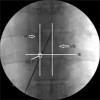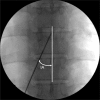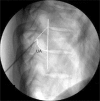Fluoroscope guided epidural needle insertioin in midthoracic region: clinical evaluation of Nagaro's method
- PMID: 22679541
- PMCID: PMC3366311
- DOI: 10.4097/kjae.2012.62.5.441
Fluoroscope guided epidural needle insertioin in midthoracic region: clinical evaluation of Nagaro's method
Abstract
Background: In the midthoracic region, a fluroscope guided epidural block has been proposed by using a pedicle as a landmark to show the height of the interlaminar space (Nagaro's method). However, clinical implication of this method was not fully evaluated. We studied the clinical usefulness of a fluoroscope guided thoracic epidural block in the midthoracic region.
Methods: Twenty four patients were scheduled to receive an epidural block at the T6-7 intervertebral space. The patients were placed in the prone position. The needle entry point was located at the junction between midline of the pedicle paralleled to the midline of the T7 vertebral body (VB) and the lower border of T7 VB on anteroposterior view of the fluoroscope. The needle touched and walked up the lamina, and the interlaminar space (ILS) was sought near the midline of the VB at the height of the pedicle.
Results: The authors could not insert an epidural needle at T6-7 ILS in two patients and it was instead inserted at T5-6 ILS. However, other patients showed easy insertion at T6-7 ILS. The mean inward and upward angulations were 25° and 55° respectively. The mean actual depth and calculated depth from skin to thoracic epidural space were 5.1 cm and 6.1 cm respectively. Significant correlation between actual needle depth and body weight, podendal index (kg/m) or calculated needle depth was noted.
Conclusions: The fluorposcope guided epidural block by Nagaro's method was useful in the midthoracic region. However, further study for the caudal shift of needle entry point may be needed.
Keywords: Analgesia; Epidural; Fluoroscopy; Thoracic vertebrae.
Figures






Similar articles
-
Fluoroscopically guided epidural block in the thoracic and lumbar regions.Reg Anesth Pain Med. 2006 Sep-Oct;31(5):409-16. doi: 10.1016/j.rapm.2006.06.006. Reg Anesth Pain Med. 2006. PMID: 16952811
-
Assessing the Agreement Between Radiologic and Clinical Measurements of Lumbar and Cervical Epidural Depths in Patients Undergoing Prone Interlaminar Epidural Steroid Injection.Anesth Analg. 2017 May;124(5):1678-1685. doi: 10.1213/ANE.0000000000001839. Anesth Analg. 2017. PMID: 28099288 Free PMC article.
-
Ultrasound imaging of the thoracic spine in paramedian sagittal oblique plane: the correlation between estimated and actual depth to the epidural space.Reg Anesth Pain Med. 2011 Nov-Dec;36(6):542-7. doi: 10.1097/AAP.0b013e31823217e7. Reg Anesth Pain Med. 2011. PMID: 22005658
-
Real-time ultrasound-guided low thoracic epidural catheter placement: technical consideration and fluoroscopic evaluation.Reg Anesth Pain Med. 2021 Jun;46(6):512-517. doi: 10.1136/rapm-2021-102578. Epub 2021 Apr 23. Reg Anesth Pain Med. 2021. PMID: 33893174
-
Incidence of lower thoracic ligamentum flavum midline gaps.Br J Anaesth. 2005 Jun;94(6):852-5. doi: 10.1093/bja/aei133. Epub 2005 Apr 7. Br J Anaesth. 2005. PMID: 15817710 Review.
Cited by
-
Evaluation of a modified ultrasound-assisted technique for mid-thoracic epidural placement: a prospective observational study.BMC Anesthesiol. 2024 Jan 19;24(1):31. doi: 10.1186/s12871-024-02415-x. BMC Anesthesiol. 2024. PMID: 38243195 Free PMC article.
-
Localization of epidural space: A review of available technologies.J Anaesthesiol Clin Pharmacol. 2017 Jan-Mar;33(1):16-27. doi: 10.4103/0970-9185.202184. J Anaesthesiol Clin Pharmacol. 2017. PMID: 28413269 Free PMC article. Review.
-
Real-time ultrasound-guided versus anatomic landmark-based thoracic epidural placement: a prospective, randomized, superiority trial.BMC Anesthesiol. 2022 Jun 25;22(1):198. doi: 10.1186/s12871-022-01730-5. BMC Anesthesiol. 2022. PMID: 35752755 Free PMC article. Clinical Trial.
-
Soft System Based on Fiber Bragg Grating Sensor for Loss of Resistance Detection during Epidural Procedures: In Silico and In Vivo Assessment.Sensors (Basel). 2021 Aug 6;21(16):5329. doi: 10.3390/s21165329. Sensors (Basel). 2021. PMID: 34450771 Free PMC article.
-
Predicting clinical entry point for thoracic epidural catheter insertion during paramedian approach: A prospective observational study.J Anaesthesiol Clin Pharmacol. 2024 Apr-Jun;40(2):248-252. doi: 10.4103/joacp.joacp_448_22. Epub 2024 Apr 26. J Anaesthesiol Clin Pharmacol. 2024. PMID: 38919420 Free PMC article.
References
-
- De Cosmo G, Aceto P, Gualtieri E, Congedo E. Analgesia in thoracic surgery: review. Minerva Anestesiol. 2009;75:393–400. - PubMed
-
- Sawchuk CW, Ong B, Unruh HW, Horan TA, Greengrass R. Thoracic versus lumbar epidural fentanyl for postthoracotomy pain. Ann Thorac Surg. 1993;55:1472–1476. - PubMed
-
- Lomessy A, Magnin C, Viale JP, Motin J, Cohen R. Clinical advantages of fentanyl given epidurally for postoperative analgesia. Anesthesiology. 1984;61:466–469. - PubMed
-
- Hood DD, Dewan DM. Anesthetic and obstetric outcome in morbidly obese parturients. Anesthesiology. 1993;79:1210–1218. - PubMed
-
- Konrad C, Schüpfer G, Wietlisbach M, Gerber H. Learning manual skills in anesthesiology: Is there a recommended number of cases for anesthetic procedures? Anesth Analg. 1998;86:635–639. - PubMed
LinkOut - more resources
Full Text Sources

